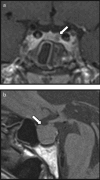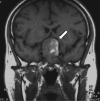Pituitary incidentaloma
- PMID: 23760707
- PMCID: PMC5922677
- DOI: 10.7861/clinmedicine.13-3-296
Pituitary incidentaloma
Keywords: Pituitary incidentaloma; magnetic resonance imaging (MRI); pituitary adenoma; pituitary apoplexy; prolactin.
Figures



References
-
- Bevan JS. Functional assessment of the pituitary. In: Hay ID, Wass JAH, editors. Clinical endocrine oncology. 2nd edition. Oxford: Blackwell Publishing; 2008. pp. 194–9. - DOI
MeSH terms
Substances
LinkOut - more resources
Full Text Sources
Other Literature Sources
Medical

